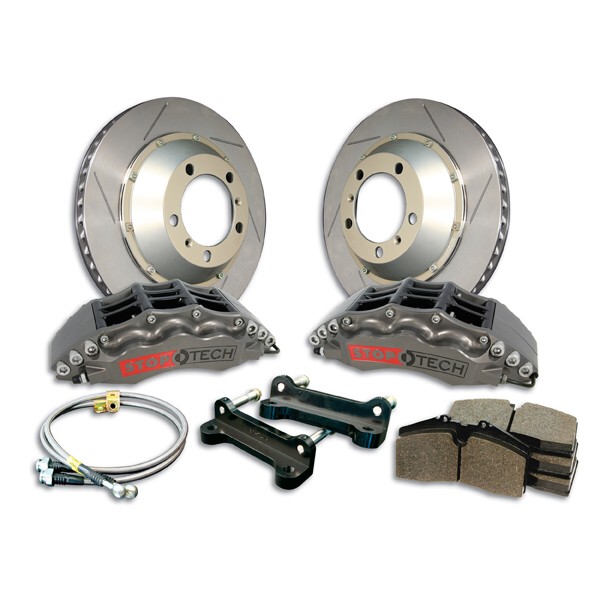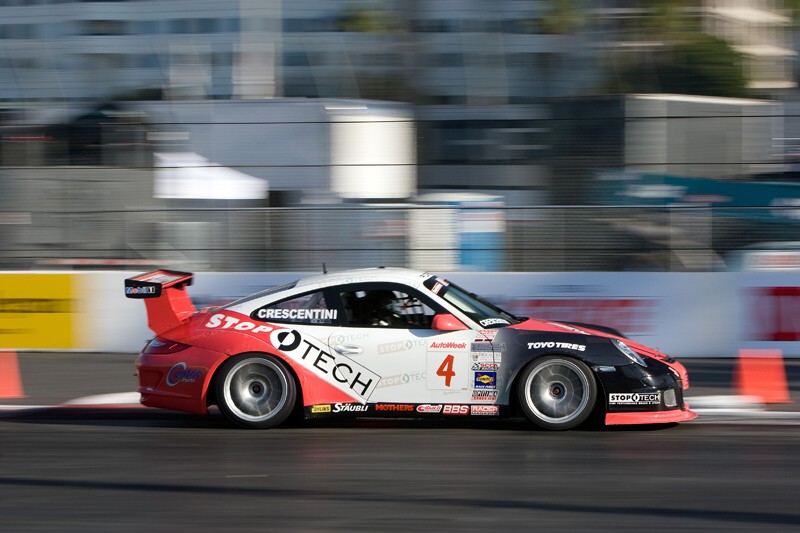An upgrade is not an upgrade when it has a negative impact on your vehicle’s performance. Brake upgrades can often fall into this category as performance enthusiasts pursue a “bigger is better” mentality without putting consideration into the concept of optimum brake bias for their  vehicles, which is also known as having balanced brakes.
vehicles, which is also known as having balanced brakes.
Optimum brake bias is obtained when a vehicle's front-to-rear brake force ratio (or force bias) exactly matches that vehicle's dynamic front-to-rear weight distribution (or weight bias). We say dynamic here because when a car is braking we have the obvious weight shift forward taking some of the static weight that was on the rear wheels and shifting it forward.
The braking systems goal then is to distribute brake force so that all four tires are simultaneously generating deceleration proportional to the four individual dynamic corner weights with only a slight calculated front bias for stability. This will maximize brake efficiency and consequently minimize stopping distance.
It is purely the combination of these two factors, brake force and dynamic corner weight that determines a vehicle's optimum brake bias. Therefore, when selecting a big brake upgrade, one should be aware that changing the force (or torque) output of the front brake components without changing the force (or torque) output of the rear brake  components can cause an undesirable shift in bias.
components can cause an undesirable shift in bias.
The most dramatic brake bias mismatches are usually brought about by big brake "upgrades" which are not properly matched to the intended vehicle. How can this occur? Any time that a bigger front rotor is installed there is a simultaneous need to decrease the effective clamping force of the caliper to offset the increased leverage and therefore torque created by the larger rotor. Unfortunately, too many of these "upgrades" do not take this factor into account, and those applications end up with both bigger rotors and the same or larger pistons which serve to drastically shift the brake bias forward. As a result, stopping distances can go up dramatically.
So why does brake bias matter? On the race track, out-braking your opponent by just two feet every lap might not sound like much, but over the course of a twenty lap sprint race it can result in a three to four car length advantage at the checkered flag. To the racer, decreased braking distance is the same as free horsepower. On the race track during qualifying or a timed lap mode these effects are amplified, as out-braking your opponent by a few feet every lap can result in a multiple car length advantage by the checkered flag. During wheel- to-wheel racing the advantage can result in a safe legal pass as well rather than cutting it too close.
to-wheel racing the advantage can result in a safe legal pass as well rather than cutting it too close.
On the street, improper bias can also lead to shorter effective brake pad life because a set of brakes not contributing as much as they could be will lead to higher front rotor temperatures and more front pad wear – the opposite of what should be the goal. In most cases drivers will experience earlier and greater ABS activations too.
For obvious reasons, the risks are highest when upgrading only one set of brakes and rotors. StopTech is the only brake upgrade company providing proper brake bias with front- only brake upgrades. In fact they have a trademark on “Balanced Brake Upgrades” as a term. This is of course key if your budget or the rules only allows for upgrading the front brakes and the rear will never be a factor.
Benefits of Balanced Brake Upgrades™
* Shorter stopping distances
* Firmer brake pedal
* Improved brake modulation
* Reduced brake pedal travel
* Optimized for ABS performance
* Optimized for OEM master cylinder
Source:
StopTech
Balanced Brake Upgrades™
www.stoptech.com
Related Articles
 Red Bull Tokyo Drift 2025 – Mad Mike Whiddett and Hiroya Minowa Defy Gravity
Red Bull Tokyo Drift 2025 – Mad Mike Whiddett and Hiroya Minowa Defy Gravity
 2026 Honda Prelude makes its North American debut
2026 Honda Prelude makes its North American debut
 Mazda RX-7 successor on the horizon
Mazda RX-7 successor on the horizon
 Bentley unveils a Bentayga with a drift mode
Bentley unveils a Bentayga with a drift mode
 Lexus unveils IS 500 Ultimate Edition
Lexus unveils IS 500 Ultimate Edition
 Quick Drive – 2025 Chevrolet Blazer EV SS
Quick Drive – 2025 Chevrolet Blazer EV SS





